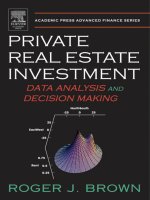Business analytics data analysis and decision making 5th by wayne l winston apendix a
Bạn đang xem bản rút gọn của tài liệu. Xem và tải ngay bản đầy đủ của tài liệu tại đây (54.74 KB, 9 trang )
part.
© 2015 Cengage Learning. All Rights Reserved. May not be scanned, copied or duplicated, or posted to a publicly accessible website, in whole or in
Business Analytics:
Data Analysis and
Appendix
Decision Making
A
Statistical Reporting
Introduction
A statistical analysis is often worthless if not reported well.
A good report must be accurate from a statistical point of view—but
maybe even more important, it must be written in clear, concise
English.
There is no single best way to write a statistical report.
However, there are some bad habits that practically all readers will
object to, and there are some good habits that will make your writing
more effective.
© 2015 Cengage Learning. All Rights Reserved. May not be scanned, copied or duplicated, or posted to a publicly accessible website, in whole or in part.
Suggestions for Good
Statistical Reporting
To some extent, the habits that make someone a good statistical
report writer are the same habits that make someone a good writer in
general.
However, there are some specific aspects of good statistical reporting
that do not apply to other forms of writing.
The next few slides list several suggestions for becoming a good
writer in general and for becoming a good statistical report writer in
particular.
© 2015 Cengage Learning. All Rights Reserved. May not be scanned, copied or duplicated, or posted to a publicly accessible website, in whole or in part.
Planning
Clarify the objective.
If there is any doubt in your mind about the objective of the report, clarify it
with the other person before proceeding.
Develop a clear plan.
Think about the best length for the report; the overall organization of the
report and how to best divide it into sections; the computer outputs you
need to include (or exclude); and the audience for whom you are writing
and what level of detail they will demand or comprehend.
Most effective statistical reports follow the outline below:
Executive summary
Problem description
Data description
Statistical methodology
Results and conclusions
Give yourself enough time.
Get started early, and don’t worry if your first effort is not perfect.
© 2015 Cengage Learning. All Rights Reserved. May not be scanned, copied or duplicated, or posted to a publicly accessible website, in whole or in part.
Developing a Report
Write a quick first draft.
Write the first draft as quickly as possible—just get something down in
writing—and then worry about improving it with careful editing later.
Edit and proofread.
The secret of good writing is rewriting.
Use spell checkers and grammar checkers.
Given enough time and planning, write a report and then reread it with a
critical eye a day or two later.
Proofread the final copy at least once.
Give your report a professional look.
An attractive report makes a good first impression.
A sloppy report, even if it presents a great statistical analysis, might never
be read at all.
© 2015 Cengage Learning. All Rights Reserved. May not be scanned, copied or duplicated, or posted to a publicly accessible website, in whole or in part.
Be Clear
Strive for clarity in your writing.
Avoid long, convoluted sentence structure.
Don’t beat around the bush.
Make sure each paragraph has a single theme that hangs together.
Provide sufficient background information.
Make sure you include enough background information to bring the reader
up to speed on the context of your report.
Tailor statistical explanations to your audience.
How much you need to explain about the meanings of statistical concepts
depends entirely on your intended audience.
Keep the statistical explanations brief, and get on with the analysis.
Place charts in the body of the report.
Place charts and tables right next to where they are referenced, rather than
at the back of the report in an appendix.
Alternatively, you can use hyperlinks to the charts and tables.
© 2015 Cengage Learning. All Rights Reserved. May not be scanned, copied or duplicated, or posted to a publicly accessible website, in whole or in part.
Be Concise
Make sure each paragraph, each sentence, and even each word has a
purpose, and eliminate everything that is extraneous.
Remember that many professionals have a one-page rule.
Let the charts do the talking.
A well-constructed chart can be a great substitute for a long, drawn-out
sentence or paragraph.
Do not omit the accompanying verbal explanations completely, but keep
them short and refer instead to the charts.
Be selective in the computer outputs you include.
Don’t include everything the computer spews out.
Don’t be afraid to alter the outputs (with a text editor or graphics package)
to help clarify your points.
If you believe a table or chart is really important enough to include in the
report, be sure to refer to it in some way in your write-up.
© 2015 Cengage Learning. All Rights Reserved. May not be scanned, copied or duplicated, or posted to a publicly accessible website, in whole or in part.
Be Precise
(slide 1 of 2)
Use very precise language in your reports.
The way a statistical concept or result is explained can affect its meaning in
a critical way.
List assumptions and potential limitations.
If your analysis relies on certain assumptions for validity, mention these in
your report, especially when there is some evidence that they are violated.
If they appear to be violated, warn the reader about the potential limitations of
your results.
Limit the decimal places.
Statistical methods are exact only up to a certain limit.
If you quote a forecast such as $5213.2345, you are not gaining precision, but
rather are showing your lack of understanding of the limits of statistical
methodology.
Instead, report a forecast of “about $5200.”
© 2015 Cengage Learning. All Rights Reserved. May not be scanned, copied or duplicated, or posted to a publicly accessible website, in whole or in part.
Be Precise
(slide 2 of 2)
Report the results fairly.
The world is not always black and white, and statistical analysts often find
themselves in gray areas.
However, you are ethically obligated to report your results as fairly as
possible.
You should not deliberately try to lie with statistics.
Get advice from an expert.
There are many specific details and nuances of statistical analysis that have
not been covered.
If you become stuck on how to write a specific part of your report because
you lack statistical knowledge, don’t be afraid to consult someone with
more statistical expertise.
© 2015 Cengage Learning. All Rights Reserved. May not be scanned, copied or duplicated, or posted to a publicly accessible website, in whole or in part.









